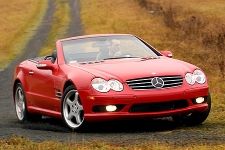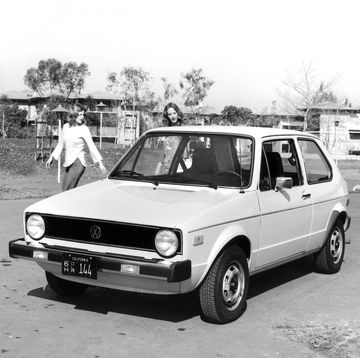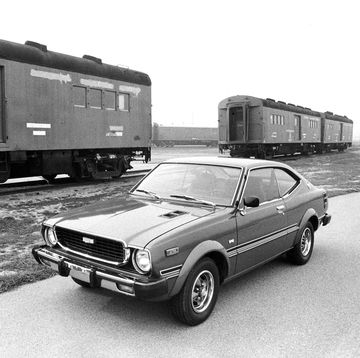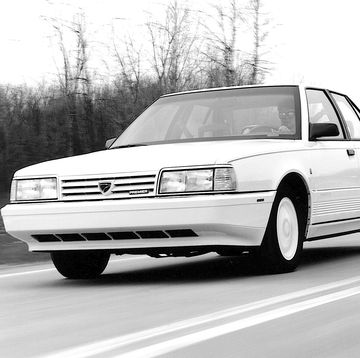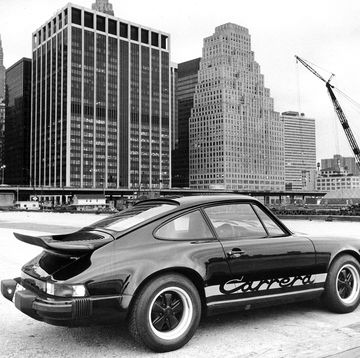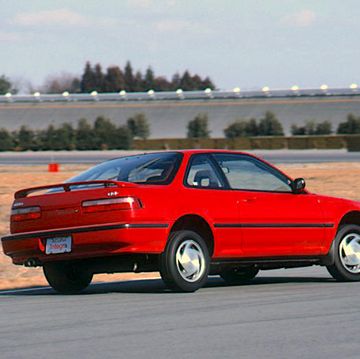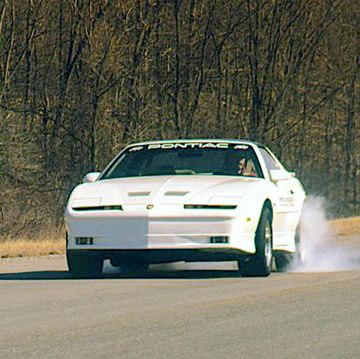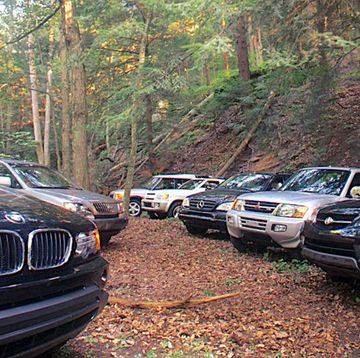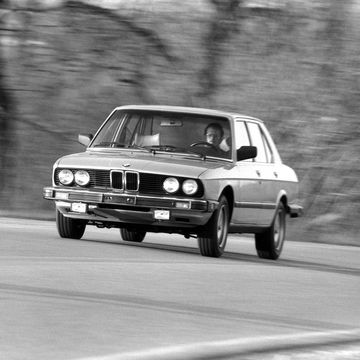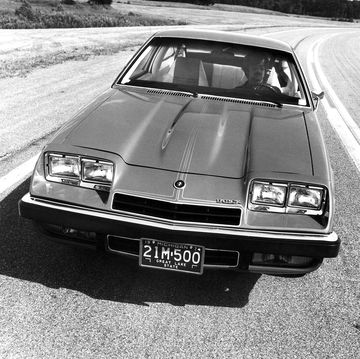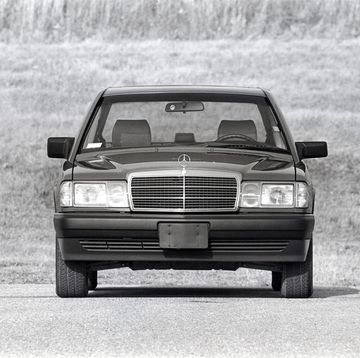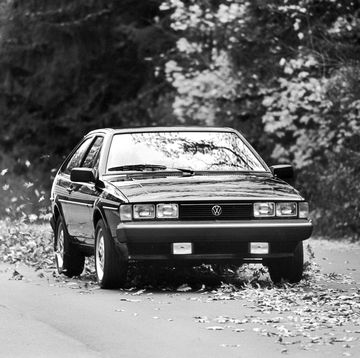From the April 2002 issue of Car and Driver.
Say what you will about the cheese-block lines and frumpy two-tone paint schemes of the outgoing Mercedes-Benz SL, it was no slave to fads. For 13 years the R129, as Mercedes engineers knew it, bucked changing fashions to embody the company's traditional love of precision engineering, contemporary technology, and restrained design. It was a silk pinstripe on a rack of polyester pretenders.
And as the R129 points its rectilinear nose into the sunset, it's reasonable to expect that the replacement, the R230, which pioneers a new electrohydraulic brake technology (see sidebar) and has a folding hardtop whose choreography would stand with a Bolshoi number, will emulate the pattern. Germans make things to endure. The Brandenburg Gate survived the Halifax bomber, for example. So shall the conservative SL stay its course against the fashion onslaught of chichi new droptops.
Or will it? Today's plutocrats want more than just safe, dignified transportation, and Mercedes' competitors are lining up to give it to them. The Porsche 911 Cabrio offers more performance, the BMW Z8 more exclusivity, the Jaguar XK8 has a more coddling interior and classically evocative lines, and the Lexus SC430 is more avant-garde. The old SL may have been content to be timeless executive wear, but the new SL wants to be this season's sauciest slip-on.
Just look at the way it flaunts itself in public. Mercedes' stylists lengthened the wheelbase by 1.8 inches, widened the track by about an inch, and shortened the overhangs to give it a road-inhaling stance. They folded down the windshield to a garish rake and draped the aluminum sheets in an alluring wedge over the big wheels. The scandalous curves are a magnet for attention and moved one young male passerby to exclaim, "Man, you must get all the women."
Don't be fooled. We don't get the women, and the new SL, despite its gorgeous shape, proves to be only a halfhearted extrovert once you take a closer look. For one thing, the stylists seem to have hit the creative wall after penning the lascivious profile. The nose bears a stock four-sided corporate grille bracketed by a variant of the C-class Mr. Peanut-shaped headlights—livened up somewhat with a tighter waist (Mrs. Peanut?). But the real offenses in our eyes are the hood and fender vents, which look cheap and gape ostentatiously. What fashion crime did the last SL's artfully subtle slots commit?
More important, the new SL moves the driving-excitement needle only incrementally, rather than substantially, out on the road. True, the new car finds 60 mph a full 0.5 second sooner than the last SL500 we tested ( C/D, December 1989), even though its SOHC 302-hp, 24-valve V-8 produces 20 horsepower less than Mercedes' old DOHC 32-valve V-8. And the holding power on the skidpad was a very sticky 0.88 g, 0.06 g better than the SL500 we tested in '89. Some credit goes to the fitment of the optional Sport package, which includes side and rear fascia changes and 18-inch wheels wearing the latest Z-rated Michelin Pilot Sports, upsized to 285/40 in the back.
But the dividends to steering precision and road communication from the revised chassis haven't fully accrued to the overall experience. The SL now enjoys more lively rack-and-pinion steering, but there's still too much cushion in the weights and responses, too much old software left over from the luxury-car department to make the wheel as sharp as it could be. For example, if the SL were a true sports roadster, the steering would give you the good, the bad, and even the irrelevant news. This SL provides a brief executive summary.
Some of the SL's dynamic shortcomings can be blamed on the weight, which despite the aluminum sheets and magnesium door castings is still 4172 pounds, about the same as a Jeep Grand Cherokee Limited. The Active Body Control system directs a hydraulic ram above each coil spring to continuously alter its spring rate in order to counter body roll, pitch, and dive. This limits the body motions in long sweepers and during hard applications of the pedals, but this heavy mechanism can't make the car feel less massive than it is all by itself. And except for allowing Mercedes to choose softer springs than it might have otherwise, ABC doesn't do anything for the ride quality, which is on the tranquil side but which degenerates into quivering concussions over Midwestern frost heaves.
The trademark trapezoidal instrument cluster is among the Mercedes icons relegated to the dustbin in the new SL. The substitute is a pair of sculpted, hooded dials that take the most direct cue not from the lumpy 300SLs of the '50s or the pagoda-roofed SLs of the '60s, but from generations of dearly departed Alfa Romeo spiders. The climate-control plate recalls something less savory--we're thinking Madonna's chrome brassiere--and the twin aluminum rings that control the temperature for driver and passenger wobble slightly in their races and feel as if they were pilfered from the Hyundai parts bin.
Mercedes did manage to blend the conflicting themes of retro wood and nouveau brushed aluminum into a warmer, more spacious, and more organic interior than in the previous SL. The exception is the door armrests, which are as hard as pig iron and brutal to the elbows. At least one can flip up the armrest to open the storage bin underneath and perch the elbow on the much softer spine of the leather-bound owner's manual.
The most familiar item in the cockpit is the COMAND system panel, which includes densely packed buttons for the radio, phone, and GPS-based navigation functions. The voice-activation feature and the oval steering-wheel buttons help sort it out, but using the system remains as taxing as herding cats. Another thing you can't do without straining is load the CD changer. The slot above the COMAND screen accommodates one music CD or one of the 11 navigation CDs (there's still no one-disc DVD system available); the changer is nestled in the left of the two cubbies behind the seats. We find that an odd place to put it, considering a Ford Focus can be optioned with an in-dash changer.
At least Mercedes has created a serene environment in which to enjoy the radio. With the top erected, the atmosphere is hushed enough to hear your passenger's tendons snapping during a postnap stretch. However, the draining of the sound swamp did expose at least one evolutionary throwback wriggling in the mud. At about 2100 rpm, a hollow, moaning resonance disturbs the cabin, thanks to an offensive frequency in the exhaust or powertrain that excites the surrounding body.
A new thing the car pictured here doesn't have, but which we sampled at Mercedes' introduction, is Keyless Go. It's a transponder shaped like a credit card that unlocks the car and allows the driver to start and stop it by pushing a button on the shifter. It promises to make a lost art of inventing new curses to call forth misplaced keys. There is no price on the option yet.
The SL's new top is without doubt the category killer. Flip up the paddle switch at console center (the small buttons to manually raise and lower the roll bar are hiding underneath), and wait 16 seconds while the aluminum and glass panels separate, somersault flat, and stack efficiently in the trunk. Once deposited, the top leaves just enough space to wedge in his and hers golf bags.
The cavity is accessible by pushing a red button on the trunk sill that electrically tilts the entire top stack to a 20-degree angle. A louver in the trunk that must be in place before the top will come down prevents potato chip crushing. With the top stowed and the stretchy mesh wind deflector in position, the occupants can debate their destination at conversational levels right up to 80 mph.
The new SL's terrific top and improved performance are the best excuses to cash in an old softtop SL and simultaneously rid the garage of its bulky detached hardtop. If those aren't reasons enough, consider that the $87,000 price may ultimately be the cheapest way to completely overhaul your appearance.
Counterpoint
Aside from an automatic climate-control system that looks as if it came from a pre-WWII Tatra, the latest SL advances the state of its breed and is a real looker. In fact, it could be argued that this is the coolest Mercedes sheetmetal since the 300SL Gullwing. It's also comfortable, techno-trick, reasonably quick (for something that still scales in north of two tons), and reasonably agile (ditto). But unless you're into such accessories as trophy wives and gold Rolexes, the new SL just isn't the sort of device that raises pulse rates. If you like envy, this ride's for you. If you want adrenaline, better wait for the AMG version. —Tony Swan
Robinson drove the SL500 home from Arizona, reminding me of a similar jaunt I made in the original 600SL. That car, too, was a people magnet, a serene cruiser, and a rocket sled. That car made me feel like a power broker, and so does this one, except here I feel like an addled magnate. Setting the clock took 15 minutes of tinkering, followed by an embarrassing consultation of the owner's manual. The futuristic top and by-wire brakes set new benchmarks, and the sinuous sheetmetal recalls elements of the original 300SL. I like it all, but I wish the dash controls were simpler. Simple controls would qualify as retro chic, wouldn't they? —Frank Markus
Is there anyone in America who doesn't pay a little more attention to the driver of a Mercedes SL? The car is such a universal icon of tasteful style and refined substance that it magically confers those qualities on anyone who drives one. The SL performs this alchemy because for nearly 50 years it has represented automotive excellence. The original Gullwings were close cousins to Le Mans winners. The recent ones have bristled with cutting-edge technology. The one common thread has been visual beauty, and this fifth-generation SL is the prettiest one in the past 30 years. It's sure to keep those valets standing up a little straighter. —Csaba Csere
Braking The Mold
This new SL introduces the most significant wrinkle to stoppers since the advent of anti-lock brakes: computer-operated brakes that take control of the calipers in a way no human could emulate without four brake pedals and the feet to work them.
The underhood heart of the Sensotronic Brake Control (SBC) system is a large aluminum valve block fitted with an electric motor for maintaining 2000 to 2300 psi of fluid pressure in an adjacent hydraulic accumulator. When you hoof the brake pedal—an electronic sensor with a spring-loaded plunger to mimic brake resistance but not the annoying ABS pushback—the computer flutters the solenoid-operated valves inside the block, releasing pressure from the accumulator to the otherwise conventional steel lines heading out to the calipers.
The computer thus has ultimate command over the pressure each caliper receives (a redundant master cylinder provides pressure to the front calipers in case of power failure) and uses its position of responsibility to provide some extra capability. For example, the system varies the brake pressure not only fore and aft but also from side to side, applying increased pressure on the laden outside wheels in a turn while relaxing the inside calipers to prevent lockup. The computer also monitors for sudden releases of the accelerator, in which case it assumes a panic situation is brewing and pumps up pressure while snuggling the pads against the rotors to prepare for a hard stop. In the rain, the system will imperceptibly pulse the brakes every few minutes to keep the pads dry, and over time it will learn your driving style and tailor the brake response.
Considering it's the first shot at virtual brakes, Mercedes and supplier Bosch got it mostly right. Tip into the pedal as lightly as you can, and the initial engagement is undetectable. Whack the pedal hard, and the car freezes in 155 feet from 70 mph, or 10 feet shorter than a Ferrari 360 Modena F1 ( C/D, September 2000). Do it six times rapidly, and the distance grows by just nine feet, still better than the Modena's best. The SL's brakes also accept stomps in mid-apex without relying on ABS or squirreling the car into oversteer.
The system's opaqueness increases during prolonged mid-effort applications, such as when rolling up to a stop sign. The pedal acquires supersensitivity, adjusting the pressure out of proportion with small pedal movements. Suddenly, it feels as if the car is lurching ahead when all you meant to do was ease the pressure slightly to stop on the appropriate dime. Release the pedal from a dead stop, and the calipers of our test car sometimes responded with an audible "clunk." With this wrinkle, Mercedes still has a little ironing to do. —AR
Specifications
SPECIFICATIONS
2003 Mercedes-Benz SL500
VEHICLE TYPE
Front-engine, rear-wheel-drive, 2-passenger, 2-door convertible
BASE PRICE (C/D EST)
$87,000
ENGINE TYPE
SOHC 24-valve V-8, aluminum block and heads, port fuel injection
Displacement: 303 in3, 4966 cm3
Power: 302 hp @ 5600 rpm
Torque: 339 lb-ft @ 2700 rpm
TRANSMISSION
5-speed automatic
CHASSIS
Suspension (F/R): multilink/multilink
Brakes (F/R): 13.0-in vented, cross-drilled disc/11.8-in vented disc
Tires: Michelin Pilot Sport, F: 255/40ZR-18 95Y R: 285/40ZR-18 97Y
DIMENSIONS
Wheelbase: 100.8 in
Length: 178.5 in
Width: 71.5 in
Height: 51.1 in
Passenger volume: 46 ft3
Trunk volume, top down/up: 8/11 ft3
Curb weight: 4172 lb
C/D TEST RESULTS
60 mph: 5.8 sec
100 mph: 14.5 sec
130 mph: 26.5 sec
Rolling start, 5–60 mph: 6.1 sec
Top gear, 30–50 mph: 3.4 sec
Top gear, 50–70 mph: 4.0 sec
1/4 mile: 14.3 sec @ 99 mph
Top speed (governor limited): 155 mph
Braking, 70–0 mph: 155 ft
Roadholding, 300-ft-dia skidpad: 0.88 g
C/D FUEL ECONOMY
Observed: 22 mpg
EPA FUEL ECONOMY
Combined/city/highway: 18/15/22 mpg
